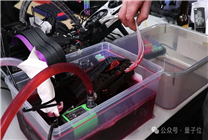Innovative DIY Oil Cooling for Graphics Cards: Boosting Performance by 16%
Summary:
- A DIY enthusiast enhances GPU performance with an oil cooling system, achieving significant gains.
- The experiment showcases impressive improvements of 7% to 16% for GTX 1080 Ti and 1060.
- This innovative cooling method may signal a new era in graphics card temperature management.
In the evolving world of computer hardware, creativity continues to thrive, especially in cooling solutions. Recently, a unique approach to enhancing graphics card performance emerged, showcasing the potential of oil cooling systems. An inventive user demonstrated significant gains in GPU performance, surpassing traditional air and liquid cooling methods.
A Fresh Perspective on GPU Cooling
The DIY oil cooling project utilized an assortment of components, including a submersible pump, an acrylic box, and a transmission cooler, combined with 8 liters of transmission oil. With this setup, the enthusiast was able to boost the performance of his GTX 1080 Ti and GTX 1060 graphics cards significantly—by 7% to 16%, respectively.
The Setup
The process began with the removal of the graphics card’s shell and fan. Once the GPU was secured inside the acrylic box, the vibrant transmission oil was poured in, and the system was powered up. The cooling mechanism operated through two circulation systems, one using a submersible pump to circulate the oil and the other relying on a transmission cooler and glycol to manage heat efficiently.
Performance Gains
Rigorous testing with popular titles such as "Shadow of the Tomb Raider" and "Far Cry 6" provided remarkable results. The GTX 1060 recorded an astonishing 16% performance increase in 3DMark tests, with its clock frequency elevating from 1886MHz to 2160MHz, marking it first in global rankings. Similarly, the GTX 1080 Ti saw an increase in operating frequency from 1960MHz to 2114MHz, translating to a 7% boost in gaming performance.
The Science Behind Oil Cooling
Concerns often arise regarding whether oil can effectively dissipate heat. The answer is affirmative; fluids like gearbox and mineral oils are adept at absorbing heat produced by graphics cards. They provide the added benefit of insulation, reducing the risk of short-circuiting the GPU. While oil cooling may not surpass the efficiency of methods like liquid nitrogen or water cooling, it offers a viable alternative that many enthusiasts are exploring.
What Makes It Work?
This innovative cooling system’s success results from its ability to transport heat away efficiently. The circulation of transmission oil helps maintain lower temperatures, allowing the graphics cards to push their limits without overheating. As users explore this method, many are sharing their variations, such as integrating fans, dry ice, or distilled water to optimize cooling further.
Maintenance Considerations
Oil cooling systems require careful maintenance. One drawback is the potential for dirt accumulation, which necessitates cleaning. However, maintaining the system is straightforward—using alcohol or white wine for cleaning is suggested, effectively restoring components to a like-new condition.
Why Choose DIY Oil Cooling?
For those considering a DIY oil cooling system, the question arises: Why go through this elaborate process? The answer lies in the thirst for performance. As gaming and graphics-intensive applications continue to demand more from GPUs, alternative cooling methods like oil immersion provide exciting possibilities for improvement. With proper setup and maintenance, these systems can yield significant benefits and uniquely push hardware performance boundaries.
Conclusion
The rise of DIY oil cooling for graphics cards represents a turning point in thermal management strategies within the enthusiast community. The ability to achieve performance enhancements through innovative cooling techniques showcases the creativity of hardware enthusiasts and opens doors to potential future advancements. As technology continues to evolve, the exploration of unconventional methods may yield better and more efficient cooling solutions that redefine what is possible in gaming and computing.
In an age where optimal performance is paramount, experimenting with methods like oil cooling may not only be a trend but a glimpse into the future of GPU management. As enthusiasts share their findings and push the limits of what’s feasible in cooling, the boundaries of hardware performance may very well be redefined.




